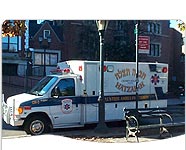 |
 
Teens and Diabetes: The Smoking Gun?
By Neil Osterweil , MedPage Today Staff Writer- Reviewed by Zalman S. Agus, MD; Emeritus Professor at the
University of Pennsylvania School of Medicine.
Source News Article: CBS News, MSNBC, Washington Post (Registration Req.)
MedPage Today Action Points
• Advise adolescents and their parents of the increased risk of the metabolic syndrome (and all of its
consequences) associated with smoke exposure as well as the other known risks of smoking.
ROCHESTER, N.Y., Aug. 2-Teens who smoke or breathe in second-hand smoke are at increased risk for developing
the metabolic syndrome, a precursor to diabetes and heart disease.
The risk is especially great for teens who are already overweight, reported investigators at the University
of Rochester here and in the online and Aug. 9 print issues of Circulation: Journal of the American Heart
Association.
Nearly one-fourth of all overweight teens who smoked had the metabolic syndrome, compared with about 5% of
overweight kids who neither smoked nor were exposed to the smoke of others, said Michael Weitzman, M.D., of the
University of Rochester and executive director of the American Academy of Pediatrics Center for Child Health
Research.
Having any exposure to smoke increases the risk of developing the metabolic syndrome by nearly fivefold, and
being an active smoker increases the risk by at least sixfold, he said.
"The obesity epidemic is truly a worrisome and consuming issue, and these data demonstrate that there are
certain subsets of overweight young people who are especially at risk for premature morbidity and mortality for
cardiovascular and diabetic related complications," Dr. Weitzman said in an interview.
In a study of nearly 2,300 adolescents, the researchers found that the risk that teens would have the metabolic
syndrome rose in sync with their degree of exposure to cigarette smoke. Overall, 5.6 % of those in the study had
the metabolic syndrome, as determined by the presence of at least three risk factors.
Among teens who didn't smoke and had no second-hand smoke exposure, 1.2% had the metabolic syndrome, compared
with 5.4% of those with some smoke exposure, and 8.7% of those who were active smokers (p<0.001).
The effects of smoking were even more dramatic among teens who were already on the path to cardiovascular
disease and diabetes by virtue of being overweight or at-risk for overweight. Among these adolescents, 5.6% of
non-exposed individuals had the metabolic syndrome, as did 19.6% of the exposed-teens who didn't smoke themselves,
and 23.6% of the teens who were active smokers (p<0.01).
In multivariable logistic regression analyses among all adolescents, environmental tobacco smoke exposure was
independently associated with the metabolic syndrome (environmental tobacco smoke exposure: odds ratio, 4.7, 95%
CI, 1.7 to 12.9; active smoking: odds ratio, 6.1; 95% CI, 2.8 to 13.4).
The investigators studied 2,273 adolescents, ages 12 to 19, using data from National Health and Nutrition
Examination Survey III (NHANES III 1988 to 1994). The kids and their parents were asked whether they or anyone in
the household smoked, and the adolescents received physical exams and lab tests, including measurement of levels
of serum cotinine (the active metabolite of nicotine) as a marker for exposure to cigarette smoke.
Active smokers were those who had cotinine levels of more than 15 ng/mL or who reported smoking in the past
five days. Environmental tobacco exposure, or second-hand smoke, was determined if the teen had cotinine levels
of 0.5 ng/mLor greater and reported no smoking within the previous five days. Those who were determined to be
unexposed had undetectable serum cotinine, no self-report of smoking, and no reported smoking in the home.
Lacking a standardized definition of the metabolic syndrome in teens, the investigators defined it as the
presence of three or more of the following: waist circumference at least in the 90th percentile for age and sex;
blood pressure at or above the 90th percentile for age, sex and height; hypertriglyceridemia; low HDL, or elevated
fasting plasma glucose.
They found that among the teens who abstained from smoking, 67% had cotinine levels between .05 and 15 ng/mL,
indicating exposure to second-hand smoke.
They also found that in addition to overweight teens, certain subgroups appeared to be at increased risk for
the metabolic syndrome in general. The syndrome occurred in 8.1% of all boys, compared with 2.9% of all girls
(male gender OR: 3.3; 95% CI: 1.6-6.6; p<0.001). The rate among Mexican-American teens was 6.7%, compared with
6.5% among non-Hispanic whites, and was lower in blacks at 3.1% of African Americans (OR: 0.3; 95% CI: 0.1-0.6;
p<0.003). These findings are consistent with other studies, the investigators noted.
The relationship between smoking and the metabolic syndrome could be due to the independent link between
tobacco use and insulin resistance, which may accelerate atherosclerosis. Tobacco has also been linked to lipid
abnormalities such as increased LDL and decreased HDL, as well as endothelial dysfunction and hypercoagulable
states, Dr. Weitzman and colleagues commented.
"Although there may be reason to celebrate decreasing rates of active and passive exposure to tobacco smoke,
one in five adolescents are still actively smoking, and an additional two thirds of all adolescents are exposed
to tobacco smoke as measured by biological markers, with an approximately fourfold increase in the risk of the
metabolic syndrome among adolescents who are overweight and at risk for overweight," the investigator
concluded.
"Considering that tobacco and obesity are individually the two leading causes of preventable death in the
United States, these findings may have profound implications for the future health of the public."
Related articles:
• Abnormal Lung CT Scan May Prompt Smokers to Quit
http://www.medpagetoday.com/Pulmonary/LungCancer/tb1/856
• ASCO: Nicotine Vaccine Helps Smokers Quit, Maybe for Good
http://www.medpagetoday.com/HematologyOncology/LungCancer/tb1/1049
Primary source: Circulation: Journal of the American Heart Association. Source reference: Circulation.
2005;112
________________________________________
Disclaimer: The information presented in this activity is that of the authors and does not necessarily
represent the views of the University of Pennsylvania School of Medicine, MedPage Today, and the commercial
supporter. Specific medicines discussed in this activity may not yet be approved by the FDA for the use as
indicated by the writer or reviewer. Before prescribing any medication, we advise you to review the complete
prescribing information, including indications, contraindications, warnings, precautions, and adverse effects.
Specific patient care decisions are the responsibility of the healthcare professional caring for the patient.
Please review our Terms of Use. © 2004-5 MedPage Today, LLC. All Rights Reserved.
The above is for general informational purposes only. Always consult your
physician regarding specific medical issues and call Hatzalah or your local
ambulance service in the event of an emergency.
Back to Digest Index
|









